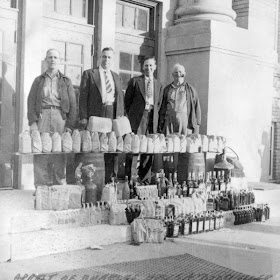
Colorado's dry period was peppered with loopholes
By Rob Carrigan, robcarrigan1@gmail.com
The “liquor question” was considered early in most of the Rocky Mountain West, by some accounts, because of the political power of various women’s movements in the region. Groups like the Anti-Saloon League and the Women’s Christian Temperance Union pushed for voluntarily abstaining from the demon “John Barleycorn,” but organization’s like Prohibition Party sought direct legislation.
In Colorado, the anti-liquor forces couldn’t universally agree on tactics. Local option laws, in place in some of the state’s communities continuously since the 1880s, showed a wide range of ideas.
According to Ansel Watrous’ History of Larimer County, “The town was full of idle and vicious men, driftwood from railroad and ditch camps, irresponsible creatures, without home or friends who hung about the saloons and brothels.”
“With an increase in crime and arson,” wrote Erin Udell in a recent article in the Rocky Mountain Collegian. “The city kept raising liquor license prices until they reached $1,000 from the original $300. Eventually in 1884, the Fort Collins city council took its first stab at prohibition, making the sale and consumption of alcohol illegal.”
Udell says fines for distributing alcohol were lower than the original liquor license prices and the city lost money, so it reinstated the sale of alcohol.
By that time, Christian temperance movements had become prominent in the West, placing added pressure on city officials to reinstate prohibition.
“In 1895, many Fort Collins residents got their wish when Frederick R. Baker, a known advocate for the temperance movement, became mayor and put prohibition in effect the next year, 24 years before the nation-wide prohibition of alcohol,”
Udell quotes Treloar Bower, the curator of education for the Fort Collins Museum. “Prohibition started earlier here than in other parts of the county most likely because of the greater influence and louder voice possessed by the women of our community, many who were for temperance… In general, women in the West held greater standing in society than back east.”
“While Colorado was the second state to give voting rights to women — Wyoming was first — Colorado was first to do so by public referendum. This means the majority of voting men in the state voted to allow women that right,” notes Udell.
“In 1912, an amendment to prevent the manufacture and sale of liquor was submitted to the electorate,” wrote Carl Ubbelohde, Maxine Benson and Duane A. Smith in A Colorado History. “The voters defeated the proposal. But that defeat stirred the various groups to common action. Submerging their differences, they sponsored another amendment two years later. This time the voters answered the question of ratification affirmatively, approving an experiment in social engineering, despite a two-to-one rejection of the amendment in Denver. The ‘wet’ forces in the capital city threatened to use the new ‘home rule’ prerogatives of the city to escape the effect o the law, but on Jan 1, 1916, prohibition became the rules in Denver and all of Colorado.”
Colorado was joined by six other states, (Iowa, Oregon, Washington, Idaho, Arkansas, and South Carolina) at that stroke of midnight as 1500 saloons, 500 hotels, restaurant and drugstores stopped selling, and 12 beer breweries closed.
“As first passed into law, Colorado's dry period was peppered with loopholes. One was letting residents purchase alcohol for religious and medicinal purposes. Shortly after the law went into effect, the city issued 16,000 prescription forms for doctors, who could prescribe four-ounce doses of liquor for needy patients with each form. One particularly pious congregation was nabbed by authorities for consuming 400 gallons of "sacramental wine" in a month. Under a later revision, individuals were allowed two pints of wine and twenty-four quarts of beer each month for personal consumption. Denver city auditor Fred Stackhouse noted in 1917 that the city issued 59,339 liquor permits to individuals,” wrote Dick Kreck in a 2009 story for the Denver Post.
“Another loophole allowed beer and spirits to be imported for personal use from wet states. Starting in 1916, an estimated $3,000 to $5,000 of whiskey a month was pouring across the Wyoming-Colorado border. One "importer" was nabbed with 2,000 pints of whiskey disguised as olive oil and salad dressing,” says Kreck.
“Despite several failed attempts to let Denver go its own way on the issue (including a measure to allow beer but not hard liquor), the city joined the rest of Colorado when the state officially went dry on January 1, 1916. The state legislature tightened the law in November 1918, banning any form of alcohol. Citizens were allowed to keep alcohol in their homes, but since its manufacture and distribution were illegal, it was a moot point — although it made enforcement even more difficult.”
With prohibition, many saloons became lunch counters and soft drink fountains and for the first time, women (other than those working the saloons) were welcomed.
"Dainty, high-heeled feet rested on the familiar brass rail, accustomed in the past to nothing but a trousered tread," reported the Rocky Mountain News at the time.
###
Arrest of Charles Hough, bootlegger, about 1917
Four men stand near hundreds of bottles of bootlegged wine, beer, and liquor on the steps of a building in Kansas. Beer bottles wrapped in paper are arranged on a table made from barrels and wood plank. Whiskey, gin, and wine bottles are arranged on the steps below the table, next to a still. Western History, Denver Public Library.
No comments:
Post a Comment